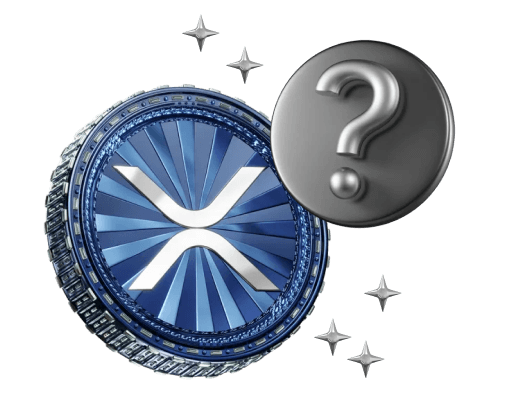
Before Ripple: The Genesis of a Digital Bridge
To understand XRP, we must go back to 2011, before the company Ripple was formed. A team of developers—David Schwartz, Jed McCaleb, and Arthur Britto—set out to create a new digital asset. Their objective was not to copy Bitcoin but to build a superior system that was faster, more sustainable, and specifically designed for financial institutions.
They developed the XRP Ledger (XRPL), a decentralized, open-source blockchain. Upon its creation, they instantly generated the ledger's entire supply of its native digital asset, XRP, bringing 100 billion tokens into existence. Unlike Bitcoin, XRP is not mined; its total supply was created at the outset. In 2012, Chris Larsen joined the founders, and they established a company called OpenCoin, which was later rebranded to Ripple. The founders gifted approximately 80 billion XRP to the company to help build an ecosystem around the asset. This decision established the often-confused relationship between the independent asset, XRP, and the private company, Ripple.
The Engine Room: Deconstructing the XRP Ledger
At the core of XRP lies the XRP Ledger (XRPL), its underlying technology. Unlike Bitcoin, which uses an energy-intensive 'proof-of-work' mining process to validate transactions, the XRPL employs a more efficient method known as a Federated Consensus mechanism.
In this system, a select group of independent servers, called validators, compare their versions of the transaction ledger. Within seconds, they vote on which transactions are valid. If an overwhelming consensus is reached, the transactions are permanently confirmed and added to the ledger. This process takes only 3 to 5 seconds to complete.
These validators are operated by a diverse group of participants, including universities, exchanges, and businesses. A subset of these trusted validators forms a Unique Node List (UNL). For a transaction to be approved, a supermajority of over 80% of these UNL validators must agree on its validity. This design makes the XRPL incredibly fast, capable of handling around 1,500 transactions per second, with fees costing a fraction of a cent. Its high-performance architecture makes XRP well-suited for its primary use case: global payments.
Company vs. Coin: Untangling Ripple and XRP
Understanding the distinction between Ripple and XRP is crucial. Ripple is a US-based private financial technology company. XRP is an independent, open-source digital asset on the XRP Ledger. Ripple cannot control the XRP Ledger, just as Google cannot control the internet. The ledger would continue to operate even if the company Ripple ceased to exist.
The connection is that Ripple is the largest single holder of XRP and uses the asset in its global payments network, RippleNet. The primary product that uses XRP is On-Demand Liquidity (ODL), which leverages XRP as a bridge currency to facilitate instant cross-border payments.
For example, if a UK bank needs to send pounds to a Mexican bank to be paid out in pesos, the traditional process involving pre-funded accounts is slow and capital-intensive. With ODL, the UK bank can convert pounds to XRP, send the XRP instantly, and a liquidity provider in Mexico converts the XRP to pesos—all within seconds. XRP serves as a neutral bridge between the two fiat currencies.
To manage its holdings and prevent market disruption, Ripple has placed the majority of its XRP in a series of cryptographically-secured escrow accounts. Each month, one billion XRP is released from escrow. Ripple can sell these tokens to fund operations or supply them to ODL partners. Any unused portion is returned to a new escrow account at the end of the month.
Beyond the Buzz: Practical Applications of XRP
While often discussed theoretically, XRP and the XRP Ledger have several practical applications already in use. Its primary function is in cross-border payments, where Ripple's ODL service offers a faster, more capital-efficient alternative to the traditional correspondent banking system. The minimal transaction fees also make XRP suitable for microtransactions, such as tipping content creators or making in-game purchases, where fees on other networks would be too high. Furthermore, the XRPL supports tokenization, featuring a built-in decentralized exchange and the ability to issue new tokens. This allows developers to create other digital assets, from stablecoins to representations of real-world assets, that can benefit from the ledger's speed and low costs. Many proponents envision the XRPL evolving into a universal settlement layer, or an 'internet of value', where Central Bank Digital Currencies (CBDCs) and other assets can be exchanged seamlessly.
The Two Sides of the Digital Coin: Promise and Peril
The Compelling Advantages
XRP's design provides several powerful strengths that distinguish it in the crypto market. Transactions settle in 3-5 seconds, a significant improvement over Bitcoin's average of 10 minutes or more. The standard transaction fee is just 0.00001 XRP, making it one of the most cost-effective networks. The XRPL is also highly scalable, built to handle 1,500 transactions per second, with the potential to match major payment processors like Visa. Finally, because it avoids proof-of-work mining, the XRPL is eco-friendly, consuming negligible energy compared to networks like Bitcoin.
The Persistent Criticisms
Despite its technical merits, XRP faces valid criticisms. The most common concern relates to centralization. Ripple's large XRP holdings and the structure of the default Unique Node List (UNL) have led to fears that the network is not sufficiently decentralized. Additionally, XRP has faced intense regulatory scrutiny due to its close ties with a corporate entity, culminating in a lawsuit from the U.S. Securities and Exchange Commission (SEC). Lastly, like all cryptocurrencies, XRP is subject to extreme price volatility, making it a risky asset for both investment and institutional use.
The Digital Contenders: How XRP Stacks Up
XRP vs. Bitcoin (BTC)
XRP and Bitcoin were designed for different purposes. Bitcoin was created as a peer-to-peer electronic cash system, a decentralized alternative to fiat money. In contrast, XRP was designed specifically as a payment settlement asset for financial institutions. Their creation methods also differ: Bitcoin is mined via proof-of-work with a maximum supply of 21 million, whereas XRP's full supply of 100 billion was created at its launch. This results in significant performance differences, with XRP offering faster, cheaper, and more energy-efficient transactions.
XRP vs. Ethereum (ETH)
Ethereum's primary function is to serve as a global computer for running decentralized applications (dApps) and smart contracts, while XRP's focus is specialized on payments. Ethereum now uses a proof-of-stake consensus mechanism, which differs from XRP's federated consensus. In their respective ecosystems, Ether (ETH) acts as the 'gas' to power network operations, whereas XRP functions as a bridge asset for transferring value.
Your First Steps: A Practical Guide to Acquiring XRP
For those in the UK interested in acquiring XRP, the process is straightforward but requires careful attention to security. This guide is for educational purposes and is not financial advice.
- Choose an Exchange or Brokerage: Sign up for a reputable cryptocurrency exchange licensed to operate in the UK. These platforms allow you to exchange fiat currency, such as British Pounds (GBP), for cryptocurrencies.
- Complete Verification: You will need to undergo a Know Your Customer (KYC) process, which typically involves providing a photo ID and proof of address. This is a standard regulatory requirement.
- Securely Store Your XRP: After purchasing XRP, decide how to store it. A hot wallet is software connected to the internet, like a mobile app, which is convenient but less secure. Exchanges provide a custodial hot wallet, meaning they manage your keys. For maximum security, a cold wallet is a hardware device that stores your crypto offline. With a cold wallet, you have non-custodial storage, meaning you alone control the private keys to your funds.
An Investor's Lens: Analyzing XRP's Market Profile
From an investment standpoint, XRP presents a complex profile. It has consistently remained a top cryptocurrency by market capitalization, demonstrating significant longevity. Its price history includes periods of explosive growth, such as the 2017 bull run, followed by long consolidations influenced by market cycles and regulatory developments.
The investment case for XRP is tied to its utility. Proponents argue that its value will grow with the adoption of the XRP Ledger and Ripple's ODL product. If XRP becomes a standard bridge asset for a significant portion of daily cross-border transactions, its value could appreciate. However, the risks are substantial, including regulatory uncertainty, competition from other payment protocols like stablecoins and future CBDCs, and market perception of its centralization. Investors must weigh the high-risk, high-reward nature of its utility-driven proposition against market volatility and its specific legal challenges.
The Legal Gauntlet: Decoding the Landmark SEC Lawsuit
In December 2020, the U.S. Securities and Exchange Commission (SEC) filed a lawsuit against Ripple Labs, alleging that XRP was an unregistered security and that the company had conducted an illegal securities offering. The SEC's case was based on the 'Howey Test', which determines if an asset is a security based on whether there is an investment of money in a common enterprise with an expectation of profit from the efforts of others.
This case was highly significant for the crypto industry. In a pivotal 2023 ruling, a judge made a nuanced distinction that provided partial clarity. The court found that Ripple's direct sales of XRP to institutional investors did constitute an unregistered securities offering. However, the judge also ruled that XRP sold to the public on crypto exchanges—known as programmatic sales—did not qualify as securities offerings because retail buyers had different expectations. While a major victory for Ripple, the split ruling means the legal and regulatory debate in the United States is not fully resolved.
Frequently asked questions
-
What is the main difference between Ripple and XRP?
Ripple is a private financial technology company that develops payment solutions. XRP is an independent digital asset that exists on the decentralized XRP Ledger. While Ripple uses XRP in some of its products, it does not control XRP or the ledger itself. -
Is XRP a replacement for SWIFT?
XRP is not a direct replacement for SWIFT. SWIFT is a messaging system banks use to send payment instructions, while the actual money is settled slowly through correspondent banks. Ripple's network, using XRP, is designed to replace this slow settlement layer, not the messaging system. The two could potentially coexist. -
How are XRP transaction fees handled?
The small fee required for every transaction, around 0.00001 XRP, is not paid to any party. Instead, it is burned, meaning the XRP is permanently destroyed. This mechanism prevents network spam and has a slight deflationary effect on the total XRP supply over time. -
What happens to the XRP in escrow?
Each month, 1 billion XRP is released from Ripple's escrow. Ripple may sell some to fund its business or provide liquidity for its partners. Any unused XRP at the end of the month is locked back into a new escrow account set to expire at a future date. -
Why is the total supply of XRP fixed?
The supply was fixed at 100 billion tokens upon its creation to ensure a known, finite quantity. Unlike Bitcoin, which is created through mining until a cap is reached, no new XRP will ever be generated. The total circulating supply gradually decreases as transaction fees are burned.
